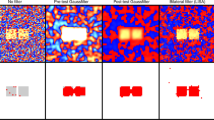Abstract
Functional magnetic resonance imaging (fMRI) is the most popular technique in human brain mapping, with statistical parametric mapping (SPM) as a classical benchmark tool for detecting brain activity. Smith and Fahrmeir (J Am Stat Assoc 102(478):417–431, 2007) proposed a competing method based on a spatial Bayesian variable selection in voxelwise linear regressions, with an Ising prior for latent activation indicators. In this article, we alternatively link activation probabilities to two types of latent Gaussian Markov random fields (GMRFs) via a probit model. Statistical inference in resulting high-dimensional hierarchical models is based on Markov chain Monte Carlo approaches, providing posterior estimates of activation probabilities and enhancing formation of activation clusters. Three algorithms are proposed depending on GMRF type and update scheme. An application to an active acoustic oddball experiment and a simulation study show a substantial increase in sensitivity compared to existing fMRI activation detection methods like classical SPM and the Ising model.




Similar content being viewed by others
References
Andersen E, Bai Z, Bischof C, Blackford LS, Demmel J, Dongarra J, Du Croz J, Greenbaum A, Hammarling S, McKenney A, Sorensen D (1999) LAPACK users’ guide, 3rd edn. SIAM, Philadelphia
Barbieri MM, Berger JO (2004) Optimal predictive model selection. Ann Stat 32(3):870–897
Blackford LS, Demmel J, Dongarra J, Duff IS, Hammarling S, Henry G, Kaufman L, Lumsdaine A, Petitet A, Pozo R, Remington K, Whaley RC (2002) An updated set of basic linear algebra subprograms (BLAS). ACM Trans Math Softw 28(2):135–151
Brezger A, Fahrmeir L, Hennerfeind A (2007) Adaptive Gaussian Markov random fields with applications in human brain mapping. J R Stat Soc C Appl Stat 56(3):327–345
Davis TA, Hager WW (1999) Modifying a sparse Cholesky factorization. SIAM J Matrix Anal Appl 20(3):606–627
Friston KJ, Holmes AP, Poline JB, Grasby P, Williams S, Frackowiak RSJ, Turner R (1995) Analysis of fMRI time-series revisited. NeuroImage 2(1):45–53
Friston KJ, Ashburner JT, Kiebel SJ, Nichols TE, Penny WD (2008) Statistical parametric mapping—the analysis of functional brain images. Academic Press, New York
George EI, McCulloch RE (1997) Approaches for Bayesian variable selection. Stat Sin 7(2):339–373
Henson R, Rugg MD, Friston KJ (2001) The choice of basis functions in event-related fMRI. NeuroImage 13(6):149
Josephs O, Turner R, Friston KJ (1997) Event-related fMRI. Hum Brain Mapp 5:243–248
Kalus S (2012) Biostatistical modeling and analysis of combined fMRI and EEG measurements. Phd thesis, Ludwig-Maximilians University, Munich
Kiehl KA, Stevens MC, Laurens KR, Pearlson G, Calhoun VD, Liddle PF (2005) An adaptive reflexive processing model of neurocognitive function: supporting evidence from a large scale (n = 100) fMRI study of an auditory oddball task. NeuroImage 25(3):899–915
Lang S, Brezger A (2004) Bayesian P-Splines. J Comput Graph Stat 13(1):183–212
Mohar B (2004) Graph Laplacians. In: Beineke LW, Wilson RJ (eds) Topics in algebraic graph theory. Cambridge University Press, Cambridge, pp 113–136
Müller P, Parmigiani G, Robert C, Rousseau J (2004) Optimal sample size for multiple testing. J Am Stat Assoc 99(468):990–1001
Müller P, Parmigiani G, Rice K (2006) FDR and Bayesian multiple comparisons rules, http://biostats.bepress.com/jhubiostat/paper115/
Newton Ma, Noueiry A, Sarkar D, Ahlquist P (2004) Detecting differential gene expression with a semiparametric hierarchical mixture method. Biostatistics 5(2):155–176
Pettitt AN, Weir IS, Hart AG (2002) A conditional autoregressive Gaussian process for irregularly spaced multivariate data with application to modelling large sets of binary data. Stat Comput 12:353–367
Rue H (2001) Fast sampling of Gaussian Markov random fields. J R Stat Soc B 63(2):325–338
Rue H, Held L (2005) Gaussian Markov random fields: theory and applications. Chapman and Hall, London
Smith D, Smith M (2006) Estimation of binary Markov random fields using Markov chain Monte Carlo. J Comput Graph Stat 15(1):207–227
Smith M, Fahrmeir L (2007) Spatial Bayesian variable selection with application to functional magnetic resonance imaging. J Am Stat Assoc 102(478):417–431
Smith M, Kohn R (1996) Nonparametric regression using Bayesian variable selection. J Econom 75(2):317–343
Smith M, Pütz B, Auer DP, Fahrmeir L (2003) Assessing brain activity through spatial bayesian variable selection. NeuroImage 20(2):802–815
Weir IS, Pettitt AN (2000) Binary probability maps using a hidden conditional autoregressive Gaussian process with an application to Finnish common toad data. J R Stat Soc C Appl Stat 49(4):473–484
Acknowledgments
We are grateful to Sara A. Kiem for supporting data acquisition of the acoustic oddball paradigm and Michael Czisch for a critical discussion of the activation results. Remarks by the editorial board and two anonymous referees were extremely helpful in revising an earlier draft. This research has been funded by the German Science Foundation, Grant FA 128/6-1.
Author information
Authors and Affiliations
Corresponding author
Rights and permissions
About this article
Cite this article
Kalus, S., Sämann, P.G. & Fahrmeir, L. Classification of brain activation via spatial Bayesian variable selection in fMRI regression. Adv Data Anal Classif 8, 63–83 (2014). https://doi.org/10.1007/s11634-013-0142-6
Received:
Revised:
Accepted:
Published:
Issue Date:
DOI: https://doi.org/10.1007/s11634-013-0142-6
Keywords
- Functional magnetic resonance imaging
- Bayesian image analysis
- Human brain mapping
- Probit link
- Markov random field priors
- Markov chain Monte Carlo




